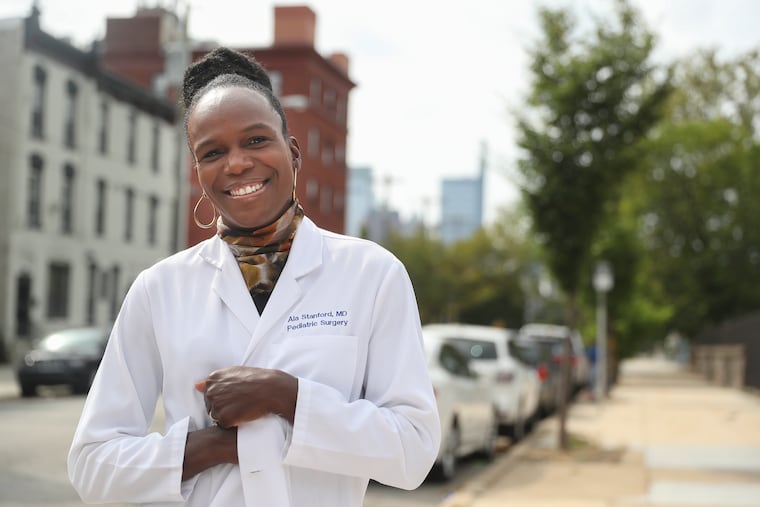Our city ranks one of the worst in the country for health. We can do better, and here’s how
In Philadelphia, people in wealthy areas live 18 years longer than those in poorer areas. Community care can close that gap.

There’s a lot to love about Philadelphia — our culture, people, and sports. However, there are times when it’s hard to fully appreciate all the city has to offer knowing it is ranked as one of the worst in the country for health outcomes. For instance, compared to other large cities, Philadelphia has higher rates of premature death (including among children), diabetes, HIV, and frequent mental and physical problems.
Those Philadelphians who are most impacted by our city’s health disparities are Black men, women, and children who don’t have the privilege of living in communities that have adequate access to quality health care — this, despite making up close to half of the city’s population. The result is appalling: the average life expectancy in most Black and Latino areas such as Nicetown/Tioga is 18 years shorter than in majority-white areas such as Center City.
We suspect that at least part of the explanation for that wide range in lifespan between neighborhoods is that Black Philadelphians are more than twice as likely as their white counterparts to be hospitalized for conditions that could be prevented with primary care. That doesn’t mean that Black Philadelphians don’t prioritize their health; in fact, when we engage in the Black community, it’s clear to us that the opposite is true. They just have less access to it.
» READ MORE: Don’t use Colin Powell’s death to bolster anti-vaccine sentiments | Opinion
In Philadelphia, neighborhoods with more Black residents have fewer or no accessible health care centers or providers who can offer screenings, vaccinations, and thorough education, prevention, and treatment for conditions such as asthma, diabetes, heart disease, cancer, and maternal health conditions, with both patience and empathy.
These disparities come at a tremendous cost to our economy and — most importantly — to the many Black children and adults in Philadelphia. We deserve better.
To bridge the health-care gap and create positive health outcomes, quality care must be more accessible. But these neighborhoods need more than just health clinics — these centers must provide care that is culturally sensitive and integrated into our city’s Black communities. Because trust starts from within communities, a place of comfort and familiarity that we must place at the heart of care delivery. With many hospitals and academic institutions not reflective of our community, these localized centers are a crucial bridge.
Notably, last year, the Philadelphia Department of Public Health released its five-year plan for addressing Health and Racial Equity. A key tenet of this plan is community engagement.
How can we effectively engage and mobilize a community-based approach? To create an enduring solution that actually serves Philadelphia’s residents of color, the city must develop a three-pronged approach.
First, to build on the department’s plan, we must identify the specific health resource gaps a community is facing. This requires an integrated and intentional strategy that brings together multiple stakeholders, including health-care providers and community members and organizations.
For instance, North Philly’s Center for Health Equity, which was founded by one of us (Ala Stanford), is in the heart of the community — near a high school, a church, and residential housing. What’s more, most providers look like the patients they serve and provide holistic, compassionate care regardless of their ability to pay. In addition, they have implemented a model of care that encourages involvement from all community members: educators, coaches, and faith leaders assist residents of all ages with scheduling and obtaining preventive care, working side by side with nurses and doctors.
While not in Philadelphia, there are similar efforts underway in other regions such as Mary’s Center, which has served 65,000 people in the Washington metro area for 35 years. The center integrates health care, education, and social services to offer individualized care.
Second, we must invest in building a more diverse health-care workforce inclusive of community members and local leaders. We should focus our efforts on recruiting, training, and upskilling these individuals who often have an intimate understanding of the community’s distinctive needs and challenges and have earned residents’ trust. Furthermore, Black and Brown patients are more apt to articulate their health-care challenges and follow medical advice when receiving care from a provider who looks like them.
We are partnering with universities, hospitals, and health-care organizations to increase the racial and ethnic diversity of their talent pipeline and workforce, promote culturally conscious care, and help support innovative health-care solutions that aim to improve health outcomes for communities of color. Such strategic partnerships can be implemented at the community level and are key to cultivating inclusive and accessible health-care solutions for Black Philadelphians.
Third, entities like the one where one of us (Howard Reid) works, Johnson & Johnson, must continue to invest in all community-based health care providers and organizations. As the burden of diseases continues to rise and more people leverage their local resources, long-term investments will increase the permanence of community-based organizations and ensure Black residents have access to proper health care regardless of where they live.
The support must come from everyone who loves the city as much as we do, including local officials, health-care companies, benefactors, and community members who live within and outside of the impacted communities. We all have a role to play.
Everyone deserves the right to accessible, compassionate, and high-quality health care. It’s time that we take steps to widely implement long-term solutions for historically marginalized communities.
Ala Stanford is a pediatric surgeon, founder of Black Doctors Consortium, former presidential appointee regional director, U.S. Department of Health and Human Services, and author of “Take Care of Them Like My Own: Faith, Fortitude, and a Surgeon’s Fight for Health Justice,” forthcoming in August 2024. Howard Reid is the head of global health equity at Johnson & Johnson.